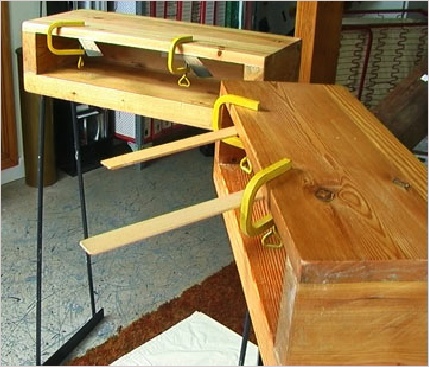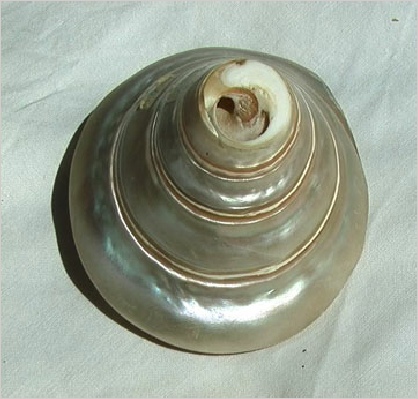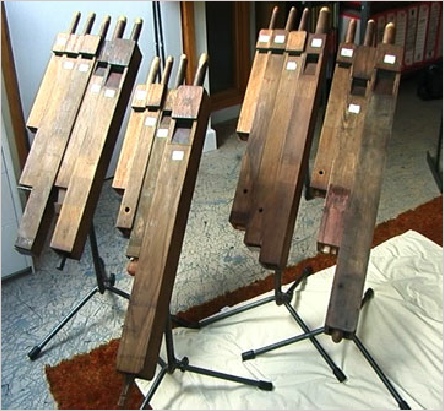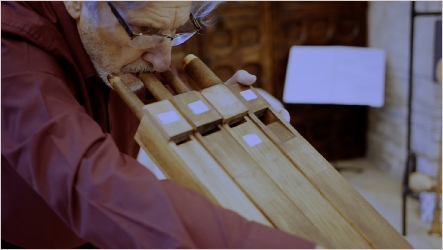Another Timbre TimHarrisonbre
at149 Frank Denyer ‘The Fish that became the Sun’
(Songs of the Dispossessed) (1991-96)
Octandre Ensemble, conductor Jon Hargreaves
Benjamin Marquise Gilmore, violin
New London Chamber Choir, director Matthew Hamilton
Consortium 5
Perc’m Percussion Ensemble (director George Barton)
Pearl and Albert Snow, child vocalists
Frank Denyer’s extraordinary, epic 60-minute piece for 40 players, many of whom are playing self-built percussion instruments made from discarded materials.
Essay by Michael Turnbull
Questions That May Yet Be Useful
Thinking about Frank Denyer’s ongoing preoccupation with the usefulness of music, I’d like to ask what an almost hour-long piece for eighty-seven instruments made of discarded material, along with a number of conventional sound-makers more or less on the periphery of the orchestral mainstream, might actually do?
plastic mineral-water bottle
To use a buzzword: how is it performative? The word has nothing to do with performance. It was introduced into linguistic theory during the 1950s by the philosopher J.L.Austin, who coined the term in order to show how the act of speaking can bring about an extra-linguistic effect. Used in an artistic context, it therefore refers to the reality a work of art brings about.
two steel armchairs with plastic meshwork
Because this reality will be recognised in how it affects and is different from the present, we ought to peg out the present first. So what’s it like now, in mid-2019?
The seas are filling up with plastic; there are more refugees in the world than at any time in human history; social division is being increasingly cultivated; public space is no longer understood as such; WWI ended over a hundred years ago; we are in the grip of an uncontrolled technological development with no idea about what it’s for; we are profoundly estranged from the earth and the forces of nature; the temperature is rising.
This (admittedly personal and absurdly brief) enumeration is important, because no matter how people will hear these sounds in future, for us right now this is their inescapable and very prominent context, if only because it’s all so constantly in the media (less so in conversation where, I imagine, we foreground a different reality). For comparison, people hearing the first public performances of the Eroica Symphony in 1805 must surely have done so in the context of the republicanism sweeping Europe at the time. Which is not to say that signs of the times, no matter how urgently they press upon the minds of the people living through them, necessarily imbue a piece of music with a particular intent or message or awareness, but to emphasise their being of their time, both in compositional impulse and in reception. They echo within specific landscapes.
metal bicycle basket
The present time is terrifying, and I for one don’t think that anything much can or will be done about it. We’re sliding towards some as yet suspected but surely dreadful inevitable.
I think we’re a disastrous species. We just destroy everything. But a minority of us will survive whatever catastrophe it was. This, I think, is optimism.
Doris Lessing, in Reluctant Heroine, BBC Imagine documentary, 2013
wooden upright chair with no seat
Yet even when ‘nothing can be done’, a piece of music does something. If only to highlight the context in which it is heard. In the first half of the1990s, when Denyer was writing The Fish that Became the Sun, past structures (certainties) were disintegrating: many states (not just in Eastern Europe) were breaking away or reuniting; the post-Yugoslavian wars overshadowed the decade; the First Gulf War casts its shadow to this day, as do the genocide in Rwanda and the failure of the Japanese economic boom. Decay and realignment were very present on the world stage. It wasn’t a great time, but it was just possible – and felt compellingly necessary – to give events a positive future twist. Which Frank did:
When things are thrown away on a rubbish dump, they decay; things separate, becoming part of something larger. And as such they can enter into unusual alliances. They find themselves cheek by jowl with the most unexpected neighbours, and a new life starts at that moment of new alliances.
Frank Denyer, in Some Sounds Are Gates, film by Suhail Merchant, 2019
five handwritten CDs in a cardboard box
In the face of destruction, Frank Denyer makes instruments out of its result and symbol – detritus, fragments – and has them speak to us in a musical ritual. And what they say, I suggest, is this: Certainty, self-assertion and fervour are steering us into catastrophe, so here is an aesthetic of hesitance, of careful appreciation, of sharing out. Also of the broken: look at these beautiful remnants. There’s a mournful aspect to it, but it also recalls the eternal potential for new form and therefore evolution. And there’s something rather grand in its acceptance of destruction: no organ here, just a few pipes – but what a sound! Yes, it says, a life among the remains is possible.
A novel that explores this territory is Marcel Theroux’s Far North (2009). Set in a climate-changed future, and focusing very much on objects, on things from the past and how to make, repair, preserve and find them - for one’s own survival has become dependent on such skills - the narrative ultimately moves forward in a vision of love (sexual, parental) that transcends these things. What really counts is the purpose to which they are put to work in the world.
oval wooden table top
I think Denyer’s detritus instruments, and the aesthetic they embody and through which they function in the immateriality of sound, activate the principle of hope. This is what they ‘perform’ (see above, para. 2); this is the reality they bring about. They are hope generators in a time when hope is fading.
Simple things transfigured through skill and energy and time to transform them into a world one could hardly dream of.
Frank Denyer, in Some Sounds Are Gates, film by Suhail Merchant, 2019
… and what’s good about these objects is that they have a past, they’ve already had a life, and they’re still very much alive. All you have to do is give them a second chance.
Louis Pons, in The Gleaners and I, film by Agnès Varda, 2000
Another thing a musical ritual with over eighty garbage instruments might do is counterbalance ‘pataphysical knowledge – that something can’t be true but is in fact real’ (Zoran Terzic, in DIAPHANES 6/7, summer 2019). Instruments made of rubbish are an engagement with and affirmation of something no longer real (in the sense of existent) but still true. In their very fragmentation they assert a reality of destruction and loss and materiality that is an antidote to the unreality of much contemporary life. The low status of their components, now incorporated into a cultural artefact, is an echo of wholesomeness within a dominant culture for which wholesomeness, wholes or the whole no longer hold much weight – except in the sense of all, as in ‘I want it all’. These instruments are a rejection of wanting (they’ve been thrown away, haven’t they?)
A desire built up in me to work in a material of waste and softness. Something yielding with its only message a collection of lines imprinted like a friendly joke. A silent discussion of their history exposed by their new shapes. Labored commonly with happiness.
Robert Rauschenberg, Cardbirds brochure, 1971
Perfectly embodying the I-want-it-all culture are the supertalls of New York, those recent skyscrapers that can’t be true but are real, that shouldn’t exist but do, in an affront to any idea of wholes or communities and therefore to culture. On some profoundly useful imaginative level, Denyer’s instruments unmake these monstrosities. In their poverty and sophistication they collapse the walls of Jericho again. Skilfully shaking shells and swishing brooms, their players evoke a reality in which the supertalls and the culture that produced them no longer exist.
glass cider bottle
And what about culture? I’ve been using the term loosely but I hope not sloppily to mean both art and society. The fragmentary material nature of Denyer’s fish-sun instruments suggests important questions about tradition, which is always evolving or dying. But their sounds – because these seem to be both within and without tradition, both aesthetically shaped and left alone – also inevitably speak about culture. Their composer is examining formed sound – that is, music – through formed sound itself. He isn’t only creating musical form, he’s asking cultural questions through this form about the substance that cultural forms embody, or might or could embody. He’s trying to frame questions – in the perhaps still culturally recognisable form of ritual, concert, spectacle – that may yet be useful.
Michael Turnbull
Berlin, July 2019
Objects found on Adalbertstraße, Skalitzer Straße, Oranienstraße
Sleevenotes by Frank Denyer
A word about the physical layout. On stage there is a solo violinist, also a group of 4 male vocalists who often sing through eunuch flutes (see below) and are supported by a harmonium. Another group of four female vocalists have at various times to sing, clap, stamp, and use various rattles, including two giant sistra. In front of the stage are the sitar, mandolin and hammered dulcimer. Slightly further back on the stage are four players of adapted organ pipes (see below). The same group also occasionally play the quartet of crumhorns, bowed wine glasses, and sundry other small instruments. To the right of the stage there is a group comprising three double basses and a contrabassoon. At the far back of the stage in the centre are two players of assorted whistles: animal calls, small ocarinas, a conch, and a trochus shell trumpet etc. At one point two small children appear and sing a small set of songs.
The seven percussionists are positioned along each side and at the back of the audience. They play a large array of instruments consisting of 2 sets of six slate gongs, 5 glass gongs, 4 bags of glass marbles, 5 long slap sticks, 4 concrete paving stones, knife on whetstone, 5 metal scrapers, bamboo switch, 3 long sandpaper blocks, rubbed balloon, 2 pairs of glass marbles on resonators, 2 lamella dyads, 3 iron bells, 2 crotales, 3 pairs of finger cymbals, 5 steel plates, 2 anvils, 2 Balinese kettle gongs, a large cabaca, kayamba, palm fronds rattle, mango seed rattle, silver jingles, gunghuroo, 2 suspended sheets of aluminium foil, 2 gourd guiros, metal guiro, 3 hard brooms, 2 leather cushions, 2 wooden planks, 3 pairs of heavy sticks, 2 pairs of medium sticks, 2 pairs of light sticks, small triangle, rubbed glass, thick paper on frame (suspended), 2 thunder sheets, 5 friction drums, small tom tom, dholak, medium and large bodhran, large conga, 4 bass drums (various sizes), lions roar, large tabor, flexitone, quijada and a long carbon fibre fishing rod.
Finally there are eight cornets placed outside and surrounding the concert venue. They are heard only in the final section (track 14).
With the exception of those players outside, all the other musicians are required to sometimes sing, hum or clap, therefore singing can arise from any part of the auditorium.
The score is fully written out and there is no improvisation as such.
It was composed between 1991 and 1996.
There are several different tuning systems employed. The pipes are equi-heptatonic, and a modified form of this tuning is found in the music for sitar, mandolin and hammered dulcimer. The children’s songs are diatonic, as are the small sections of unison singing, other parts are chromatic with microtonal sub–divisions. The outside cornets have their own complex and idiosyncratic microtonal intonation system.
The opening is played by a solitary and heavily muted violin. The violinist re-surfaces throughout the piece, not only with memories of the opening melody but in various other guises too, once as a sort of demon folk fiddler (track 9)
The quartet of pipe players. Each player has a set has three or four stopped wooden flue pipes from an organ. These, having been glued together, are then blown by mouth. Some pipes have been given a single finger hole. While they are being played each player has to simultaneously tap the side of the pipe with a metal thimble worn on the index finger. At their initial appearance (track 3) the players seem to be absorbed in some private ritual which we witness only as distant outsiders. Later a group of unison female voices complement this strange atmosphere with a long gentle melody of their own and then two very tiny ocarinas complete the tableau.
Eunuch flutes
Eunuch flutes are instruments that have fallen completely out of use. In the seventeenth century Marin Mersenne says that in France there were concerts of eunuch flutes in four or five parts. The instrument disappeared in the eighteenth century and is now found only in museums.
A eunuch flute consists of a wooden or metal tube about 80cms long widening out slightly to form a bell. The upper end of the tube is closed by a membrane stretched across the aperture. This is covered with a pierced wooden globe. The mouthpiece is a simple round hole into which the performer sings, cut into the side of the main tube. The instrument intensifies the voice and radically alters its timbre.
These instruments colour this work throughout but are particularly prominent in the two sections of homophonic rhythmic unison (tracks 5 and 11). These sections are quite different to all the other music in the piece, being in a distorted brutal homophonic style that locks the eunuch flutes in rhythmic unison with the harmonium, three double basses and contrabassoon, also sometimes, even the violin. (Track 5) Its brutal power is unrelenting. When it eventually does pause, soft unison voices quietly emerge (all the remaining musicians vocally participate), endowing the line with a soft persistence.
Much later two small children take refuge, uncertain what to do. (Track 12) They sing:
Beetle in the corner, what will you do?
Keep very still.
Beetle in the corner, what will you do?
Fasten your coat and close your eyes,
Don’t go out.
We will – what will we do?
Beetle in the corner -
Go! Go! You’re very small and not very tall.
Beetle!
A magic horse will come along,
Take us away, take us away,
A magic horse will save us from wrong.
My Grandmother said,
“If you visit me,
You shall have gooseberry bread, apple pie, jam tarts, marzipan
If you visit me,
You shall have apple pie, gooseberry bread,
But you don’t get any if you stay in bed.”
Wake up, Wake up, Wake up
Pitter-patter, pitter-patter, pitter-patter, pitter-patter.
Beetle in the corner, what will you do?
You know what they said:
Your mother’s missing and your father’s dead!
Beetle in the corner,
Beetle.
Beetle in the corner,
Beetle, beetle, beetle.
(Track 14) In the final section the eight cornets, outside the hall, are heard in the far distance. They reveal quite another reality, and with it a very different perception of time. Perhaps it requires a while to mentally re-adjust, but it also becomes apparent that the sound of each cornet is coming from a different compass direction, and together they completely surround the hall (something that can only be hinted at in a stereo recording). All the players inside have fallen silent but after a while one or two of them tentatively try to imitate these infiltrating notes and phrases. These ‘inside’ sounds, however delicate, are very ‘present’ (real), while the cornets remain ephemeral and distant. Nevertheless, the fragile beginnings of a dialogue are hinted at. The piece concludes with repeated unisons between cornets outside, and the double basses inside.
Frank Denyer, August 2019


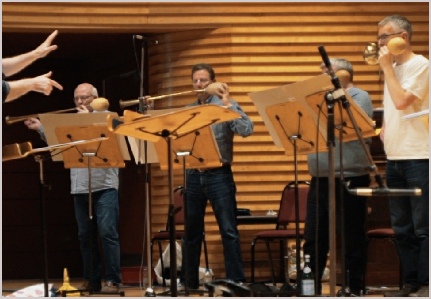
Frank Denyer playing a conch shell
Heptatonic pipes
Bowed wine glasses
Adapted organ pipes
Shell trumpet
Eunuch flute
Eunuch flutes
Wooden rulers
